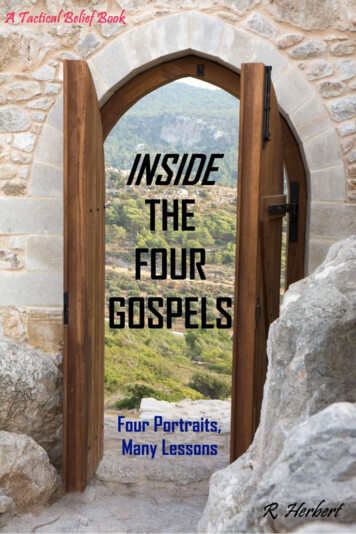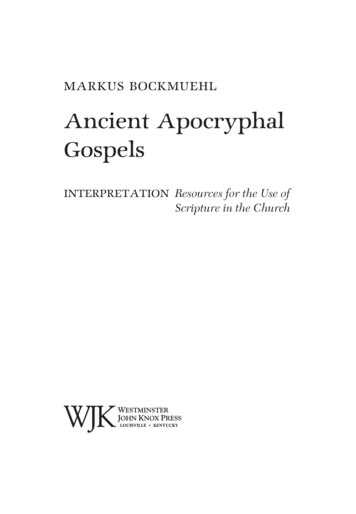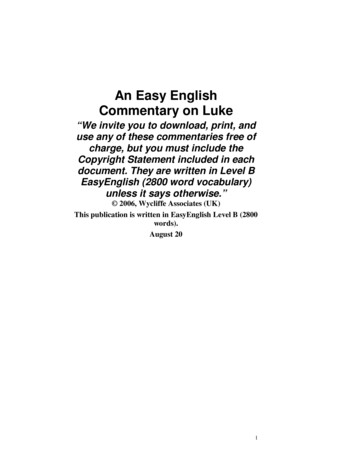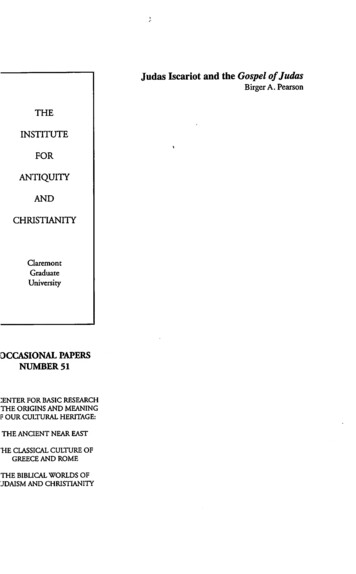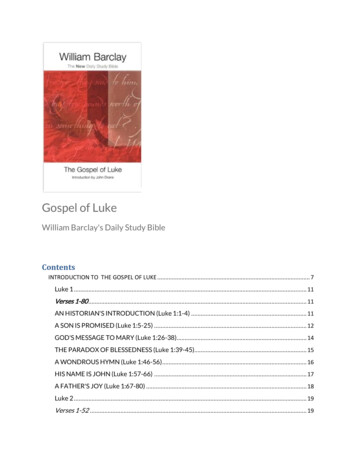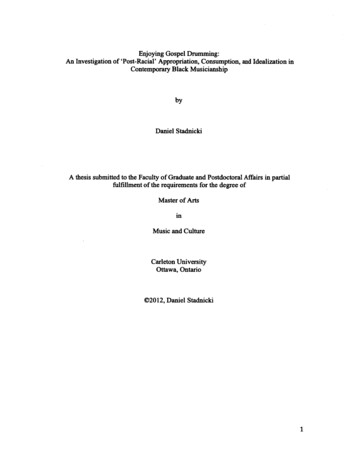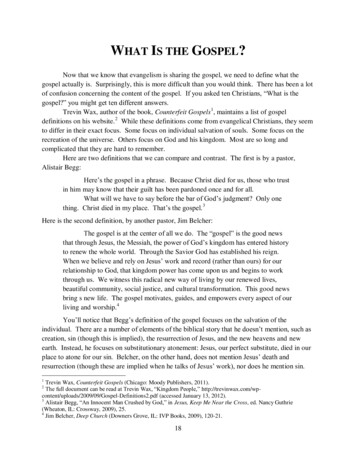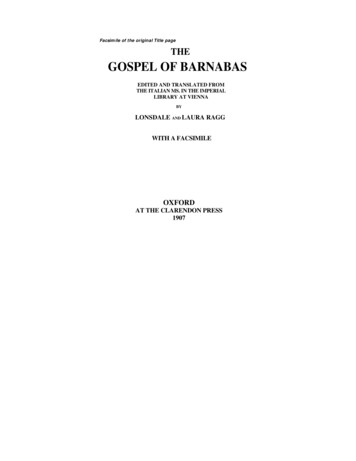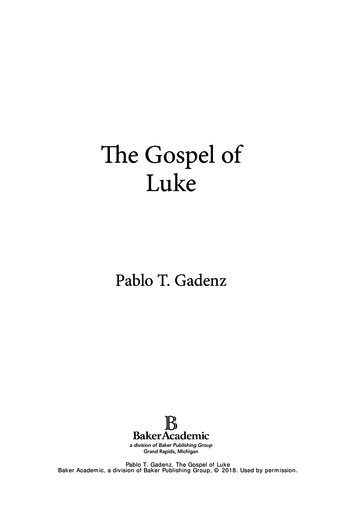
Transcription
The Gospel ofLukePablo T. GadenzKPablo T. Gadenz, The Gospel of LukeBaker Academic, a division of Baker Publishing Group, 2018. Used by permission.Gadenz GospelOfLuke TW djm.indd 57/19/18 10:56 AM
2018 by Pablo T. GadenzPublished by Baker Academica division of Baker Publishing GroupPO Box 6287, Grand Rapids, MI 49516-6287www.bakeracademic.comPrinted in the United States of AmericaAll rights reserved. No part of this publication may be reproduced, stored in a retrieval system, or transmitted in any form or by any means—for example, electronic, photocopy, recording—without the prior writtenpermission of the publisher. The only exception is brief quotations in printed reviews.ISBN 978-0-8010-3700-9Library of Congress Cataloging-in-Publication Control Number: 2018009831Nihil obstat:Monsignor C. Anthony ZiccardiCensor LibrorumJanuary 16, 2018 1973, 1978, 1984, 2011 by Biblica, Inc. Used bypermission of Zondervan. All rights reserved worldwide. www.zondervan.com. The “NIV” and “New International Version” are trademarks registered in theUnited States Patent and Trademark Office by Biblica,Inc. Imprimatur:Cardinal Joseph W. TobinArchbishop of NewarkJanuary 24, 2018Scripture quotations labeled NJB are from THE NEWJERUSALEM BIBLE, copyright 1985 by Darton,Longman & Todd, Ltd. and Doubleday, a division ofThe nihil obstat and imprimatur are official declaraRandom House, Inc. Reprinted by permission.tions that a book is free of doctrinal or moral error. Noimplication is contained therein that those who have Scripture quotations labeled NRSV are from the Newgranted the nihil obstat or imprimatur agree with the Revised Standard Version of the Bible, copyrightcontents, opinions, or statements expressed. 1989 National Council of the Churches of Christin the United States of America. Used by permission.Except as otherwise specified, Scripture versificationAll rights reserved.and quotations are from the New American Bible, revised edition 2010, 1991, 1986, 1970 Confraternity of Scripture quotations labeled RSV are from the RevisedChristian Doctrine, Washington, DC, and are used by Standard Version of the Bible, copyright 1946, 1952permission of the copyright owner. All rights reserved. [2nd edition, 1971] National Council of the ChurchesNo part of the New American Bible may be reproduced of Christ in the United States of America. Used byin any form without permission in writing from the permission. All rights reserved worldwide.copyright owner.English translation of the Catechism of the CatholicScripture quotations labeled ESV are from The Holy Church for the United States of America copyrightBible, English Standard Version (ESV ), copyright 1994, United States Catholic Conference, Inc.— 2001 by Crossway, a publishing ministry of Good Libreria Editrice Vaticana. English translation of theNews Publishers. Used by permission. All rights re- Catechism of the Catholic Church: Modifications fromserved. ESV Text Edition: 2016the Editio Typica copyright 1997, United StatesCatholic Conference, Inc.—Libreria Editrice Vaticana.Scripture quotations labeled KJV are from the KingJames Version of the Bible.Figure 1 is courtesy of the Israel Museum, collectionof the Israel Museum, Jerusalem, and courtesy of theScripture quotations labeled NET are from the NETIsrael Antiquities Authority, exhibited at the IsraelBible , copyright 1996–2016 by Biblical StudiesMuseum, Jerusalem.Press, L.L.C. http://netbible.com. Used by permission.All rights reserved.Figure 21 is courtesy of the Israel Museum, collectionof the Israel Museum,Scripture quotations labeled NETS are from A NewJerusalem, and courtesyEnglish Translation of the Septuagint, 2007 by theof the Israel AntiquiInternational Organization for Septuagint and Cognateties Authority, exhibitedStudies, Inc. Used by permission of Oxford Universityat the Israel Museum,Press. All rights reserved.Jerusalem.Scripture quotations labeled NIV are from the HolyBible, New International Version . NIV . Copyright18192021222324 7654321Pablo T. Gadenz, The Gospel of LukeBaker Academic, a division of Baker Publishing Group, 2018. Used by permission.Gadenz GospelOfLuke TW djm.indd 67/19/18 10:56 AM
ContentsIllustrations 9Editors’ on 15Outline of the Gospel of Luke 24Luke States His Purpose (1:1–4) 29God Visits His People (1:5–80) 33A Savior Is Born (2:1–52) 59The Precursor and the Son of God (3:1–4:13) 78Jesus’ Mission as Messiah (4:14–44) 97Calling Disciples and Answering Pharisees (5:1–6:11) 109The Twelve and the Sermon on the Plain (6:12–49) 126Jesus the Great Prophet (7:1–50) 138Jesus’ Parables and Power (8:1–56) 154The Messiah and Suffering Son of Man (9:1–50) 171The Journey to Jerusalem Begins (9:51–10:42) 192Prayer and Almsgiving (11:1–54) 217Genuine Disciples in a Growing Kingdom (12:1–13:21) 234The Last Are First at God’s Kingdom Banquet (13:22–14:35) 257Parables about Repentance and Riches (15:1–17:10) 271The Son of Man and the Kingdom of God (17:11–18:30) 293The King Goes Up to Jerusalem (18:31–19:44) 311Ministry in the Temple (19:45–21:38) 3297Pablo T. Gadenz, The Gospel of LukeBaker Academic, a division of Baker Publishing Group, 2018. Used by permission.Gadenz GospelOfLuke TW djm.indd 77/19/18 10:56 AM
ContentsThe Passover of the Messiah (22:1–71) 352Trial, Crucifixion, and Death (23:1–56) 371Fulfillment in Jesus’ Resurrection (24:1–53) 389Suggested Resources 405Glossary 407Index of Pastoral Topics 409Index of Sidebars 411Map 4138Pablo T. Gadenz, The Gospel of LukeBaker Academic, a division of Baker Publishing Group, 2018. Used by permission.Gadenz GospelOfLuke TW djm.indd 87/19/18 10:56 AM
IllustrationsFigure 1. Model of the temple sanctuary 37Figure 2. Annunciation of Cortona by Fra Angelico 46Figure 3. Traditional birth site of Jesus under the Church of theNativity 63Figure 4. The baptismal site Qasr al-Yahud on the Jordan River 81Figure 5. Magdala boat mosaic 113Figure 6. Galilee boat 114Figure 7. Synagogue in Capernaum 140Figure 8. Coin with reed of Herod Antipas 147Figure 9. Carved lampstand (temple menorah) 160Figure 10. Mount Arbel and the Sea of Galilee 163Figure 11. Mosaic of loaves and fish 175Figure 12. Fig tree 251Figure 13. Return of the Prodigal Son by Murillo 277Figure 14. Millstone at Capernaum 291Figure 15. Temple inscription prohibiting further entry to foreigners 295Figure 16. Jerusalem from the Mount of Olives 327Figure 17. Diagram of the temple 331Figure 18. Denarius of Tiberius Caesar 338Figure 19. Temple ruins (southwest corner) 347Figure 20. Olive trees in Gethsemane on the Mount of Olives 364Figure 21. Pilate inscription at Caesarea Maritima 373Figure 22. Church of the Holy Sepulchre 388Figure 23. Supper at Emmaus by Caravaggio 3969Pablo T. Gadenz, The Gospel of LukeBaker Academic, a division of Baker Publishing Group, 2018. Used by permission.Gadenz GospelOfLuke TW djm.indd 97/19/18 10:56 AM
Editors’ PrefaceThe Church has always venerated the divine Scriptures just as she veneratesthe body of the Lord. . . . All the preaching of the Church should be nourishedand governed by Sacred Scripture. For in the sacred books, the Father who is inheaven meets His children with great love and speaks with them; and the powerand goodness in the word of God is so great that it stands as the support andenergy of the Church, the strength of faith for her sons and daughters, the foodof the soul, a pure and perennial fountain of spiritual life.Second Vatican Council, Dei Verbum 21Were not our hearts burning [within us] while he spoke to us on the way andopened the scriptures to us?Luke 24:32The Catholic Commentary on Sacred Scripture aims to serve the ministry ofthe Word of God in the life and mission of the Church. Since Vatican Council II, there has been an increasing hunger among Catholics to study Scripturein depth and in a way that reveals its relationship to liturgy, evangelization,catechesis, theology, and personal and communal life. This series responds tothat desire by providing accessible yet substantive commentary on each book ofthe New Testament, drawn from the best of contemporary biblical scholarshipas well as the rich treasury of the Church’s tradition. These volumes seek tooffer scholarship illumined by faith, in the conviction that the ultimate aim ofbiblical interpretation is to discover what God has revealed and is still speakingthrough the sacred text. Central to our approach are the principles taught byVatican II: first, the use of historical and literary methods to discern what the10Pablo T. Gadenz, The Gospel of LukeBaker Academic, a division of Baker Publishing Group, 2018. Used by permission.Gadenz GospelOfLuke TW djm.indd 107/19/18 10:56 AM
Editors’ Prefacebiblical authors intended to express; second, prayerful theological reflectionto understand the sacred text “in accord with the same Spirit by whom it waswritten”—that is, in light of the content and unity of the whole Scripture, theliving tradition of the Church, and the analogy of faith (Dei Verbum 12).The Catholic Commentary on Sacred Scripture is written for those engagedin or training for pastoral ministry and others interested in studying Scriptureto understand their faith more deeply, to nourish their spiritual life, or to sharethe good news with others. With this in mind, the authors focus on the meaningof the text for faith and life rather than on the technical questions that occupyscholars, and they explain the Bible in ordinary language that does not requiretranslation for preaching and catechesis. Although this series is written fromthe perspective of Catholic faith, its authors draw on the interpretation of Protestant and Orthodox scholars and hope these volumes will serve Christians ofother traditions as well.A variety of features are designed to make the commentary as useful aspossible. Each volume includes the biblical text of the New American Bible,Revised Edition (NABRE), the translation approved for liturgical use in theUnited States. In order to serve readers who use other translations, the commentary notes and explains the most important differences between the NABREand other widely used translations (e.g., RSV, NRSV, JB, NJB, and NIV). Eachunit of the biblical text is followed by a list of references to relevant Scripturepassages, Catechism sections, and uses in the Roman Lectionary. The exegesis that follows aims to explain in a clear and engaging way the meaning ofthe text in its original historical context as well as its perennial meaning forChristians. Reflection and Application sections help readers apply Scriptureto Christian life today by responding to questions that the text raises, offeringspiritual interpretations drawn from Christian tradition or providing suggestions for the use of the biblical text in catechesis, preaching, or other forms ofpastoral ministry.Interspersed throughout the commentary are Biblical Background sidebarsthat present historical, literary, or theological information, and Living Traditionsidebars that offer pertinent material from the postbiblical Christian tradition,including quotations from Church documents and from the writings of saintsand Church Fathers. The Biblical Background sidebars are indicated by a photoof urns that were excavated in Jerusalem, signifying the importance of historical study in understanding the sacred text. The Living Tradition sidebars areindicated by an image of Eadwine, a twelfth-century monk and scribe, signifying the growth in the Church’s understanding that comes by the grace of the11Pablo T. Gadenz, The Gospel of LukeBaker Academic, a division of Baker Publishing Group, 2018. Used by permission.Gadenz GospelOfLuke TW djm.indd 117/19/18 10:56 AM
Editors’ PrefaceHoly Spirit as believers study and ponder the Word of God in their hearts (seeDei Verbum 8).Maps and a glossary are included in each volume for easy reference. Theglossary explains key terms from the biblical text as well as theological or exegetical terms, which are marked in the commentary with a cross (†). A list ofsuggested resources, an index of pastoral topics, and an index of sidebars areincluded to enhance the usefulness of these volumes. Further resources, including questions for reflection or discussion, can be found at the series website,www.CatholicScriptureCommentary.com.It is our desire and prayer that these volumes be of service so that more andmore “the word of the Lord may speed forward and be glorified” (2 Thess 3:1)in the Church and throughout the world.Peter S. WilliamsonMary HealyKevin PerrottaNote to ReadersThe New American Bible, Revised Edition differs slightly from most Englishtranslations in its verse numbering of Psalms and certain other parts of theOld Testament. For instance, Ps 51:4 in the NABRE is Ps 51:2 in other translations; Mal 3:19 in the NABRE is Mal 4:1 in other translations. Readers who usedifferent translations are advised to keep this in mind when looking up OldTestament references given in the commentary.12Pablo T. Gadenz, The Gospel of LukeBaker Academic, a division of Baker Publishing Group, 2018. Used by permission.Gadenz GospelOfLuke TW djm.indd 127/19/18 10:56 AM
SVNTNTSOTPNTCrepr.RSVSCIndicates that a definition of a term appears in the glossaryIndicates where a parallel account can be found in other GospelsAnchor BibleAncient Christian WritersCatechism of the Catholic Church, 2nd ed. (New York: Doubleday, 2003)Corpus Christianorum, Series Latina (Turnhout: Brepols, 1953–)chapter(s)H. Denzinger, Compendium of Creeds, Definitions, and Declarations on Matters of Faith and Morals, 43rd ed. Edited by Peter Hünermann. Latin-English(San Francisco: Ignatius, 2012)English Standard VersionFathers of the ChurchJournal of Biblical LiteratureKing James VersionLoeb Classical LibraryThe Lectionary for Mass (1998/2002 USA edition)SeptuagintMishnahNew American Bible (Revised Edition, 2011)New English TranslationA. Pietersma and B. G. Wright, eds., A New English Translation of the Septuagint(New York: Oxford University Press, 2007)New International VersionNew Jerusalem BibleNew Revised Standard VersionNew TestamentNew Testament StudiesOld TestamentPillar New Testament CommentaryreprintRevised Standard VersionSources chrétiennes (Paris: Cerf, 1943–)13Pablo T. Gadenz, The Gospel of LukeBaker Academic, a division of Baker Publishing Group, 2018. Used by permission.Gadenz GospelOfLuke TW djm.indd 137/19/18 10:56 AM
Abbreviationsv(v).WBCWSAZECNTverse(s)Word Biblical CommentaryThe Works of Saint AugustineZondervan Exegetical Commentary on the New TestamentBooks of the Old TestamentGenExodLevNumDeutJoshJudgRuth1 Sam2 Sam1 Kings2 Kings1 Chron2 myJoshuaJudgesRuth1 Samuel2 Samuel1 Kings2 Kings1 Chronicles2 ChroniclesEzraNehemiahTobJdtEsther1 Macc2 udithEsther1 Maccabees2 MaccabeesJobPsalm(s)ProverbsEcclesiastesSong of akkukZephaniahHaggaiZechariahMalachiBooks of the New TestamentMattMarkLukeJohnActsRom1 Cor2 CorGalMatthewMarkLukeJohnActsRomans1 Corinthians2 CorinthiansGalatiansEphPhilCol1 Thess2 Thess1 Tim2 TimTitusPhilemEphesiansPhilippiansColossians1 Thessalonians2 Thessalonians1 Timothy2 TimothyTitusPhilemonHebJames1 Pet2 Pet1 John2 John3 JohnJudeRevHebrewsJames1 Peter2 Peter1 John2 John3 JohnJudeRevelation14Pablo T. Gadenz, The Gospel of LukeBaker Academic, a division of Baker Publishing Group, 2018. Used by permission.Gadenz GospelOfLuke TW djm.indd 147/19/18 10:56 AM
IntroductionIn countless ways, Luke’s Gospel has been the source of inspiration for Christians for almost two thousand years. Because of Luke, hymns of praise such asthe Gloria and the Magnificat were introduced into Christian worship, prayerssuch as the Hail Mary were developed, St. Francis of Assisi began the customof the Christmas manger, and painters such as Rembrandt and Caravaggioproduced some of their great works of art.Luke’s Gospel is itself a great work of art, as the human author used all of hisliterary and narrative skills to write the longest of the four Gospels (over 19,000words, about 1,100 more than Matthew). In telling us the life and teaching ofJesus Christ, Luke’s Gospel is also a work of history, written down after carefulinvestigation and on the basis of eyewitnesses and other reliable sources (1:1–3).Moreover, it is a work of theology, written so that readers may know that theteachings of Christianity are true (1:4): Jesus Christ is indeed Savior, Messiah,Lord, and Son of God (1:35; 2:11). Luke’s Gospel is all these things, and it isalso divinely inspired, communicating to us what God wanted written for thesake of our salvation (Catechism 107).AuthorshipThe titles found at the beginning or end of the earliest extant manuscripts of theGospel, including Papyrus 75, dated by scholars to around AD 200, attributethe work to “Luke.”1 Writing around AD 180, St. Irenaeus likewise ascribes it1. Simon J. Gathercole, “The Titles of the Gospels in the Earliest New Testament Manuscripts,”Zeitschrift für die Neutestamentliche Wissenschaft 104 (2013): 66–68.15Pablo T. Gadenz, The Gospel of LukeBaker Academic, a division of Baker Publishing Group, 2018. Used by permission.Gadenz GospelOfLuke TW djm.indd 157/19/18 10:56 AM
Introductionto “Luke,” who was “Paul’s follower” and “set down in a book the Gospel thatwas preached by Paul.”2 Irenaeus says that Luke also wrote the Acts of theApostles and that Luke even accompanied Paul on some of his journeys, whichhe indicated by writing in the first-person plural, the so-called “we” sections(Acts 16:10–17; 20:5–15; 21:1–18; 27:1–28:16).3 In the same place, Irenaeus alsorefers to two verses in Paul’s letters that mention Luke, one saying that Luke iswith him (2 Tim 4:11) and one describing him as “the beloved physician” (Col4:14). There is also a third (Philem 24), in which Luke is described as one ofPaul’s fellow workers. The Muratorian Fragment and Church Fathers such asClement of Alexandria, Tertullian, Origen, Eusebius, Ambrose, Jerome, andAugustine similarly note such details.4Among modern scholars, the view that the same author wrote both theGospel and Acts is widely accepted. Also, the explanation considered mostprobable for the “we” sections in Acts is still the view that the author waspresent at the events narrated and so was a companion of Paul. Moreover,the traditional identification of this companion with the Luke mentionedin Paul’s letters, though a contested issue, is still accepted by many.5 Luke’srelative obscurity also argues in favor of the traditional view; if the Gospel’sauthor were really unknown, it would have been attributed to a more famousperson such as an apostle. Moreover, since the Gospel was dedicated to anamed person—Theophilus (1:3; see Acts 1:1)—it is implausible that it waswritten anonymously.6There are other interesting but more speculative details about Luke suggestedby some Church Fathers as well as some modern scholars. For example, sinceLuke (Greek Loukas) is a diminutive form of Lucius (Loukios), he has at timesbeen identified with the Lucius mentioned by Paul (Rom 16:21)7 and/or the Luciusof Cyrene who was with Paul and Barnabas in Antioch (Acts 13:1).8 Moreover,Antioch is mentioned by some ancient sources as Luke’s city of origin.9 Luke has2. Irenaeus, Against the Heresies 3.1.1, trans. Dominic J. Unger and M. C. Steenberg, ACW (NewYork: Newman, 2012), 30.3. Irenaeus, Against the Heresies 3.14.1.4. See the discussion in Rick Strelan, Luke the Priest: The Authority of the Author of the Third Gospel(Burlington, VT: Ashgate, 2006), 69–98.5. See the discussion in Joseph A. Fitzmyer, The Gospel according to Luke, 2 vols., AB (New York:Doubleday, 1981–85), 1:40–51; and, more recently, Michael Wolter, The Gospel according to Luke, vol. 1,Luke 1–9:50, trans. Wayne Coppins and Christoph Heilig (Waco: Baylor University Press, 2016), 6–10.6. Richard Bauckham, Jesus and the Eyewitnesses: The Gospels as Eyewitness Testimony (Grand Rapids:Eerdmans, 2006), 301.7. Origen, Commentary on Romans 10.39.1–2.8. See the discussion in Strelan, Luke the Priest, 71; Fitzmyer, Luke, 1:47.9. Anti-Marcionite Prologue for Luke; Eusebius, Ecclesiastical History 3.4.6; Jerome, Commentaryon Matthew Preface.2.16Pablo T. Gadenz, The Gospel of LukeBaker Academic, a division of Baker Publishing Group, 2018. Used by permission.Gadenz GospelOfLuke TW djm.indd 167/19/18 10:56 AM
Introductionalso been identified as the unnamed disciple “whose praise is in the gospel” (2 Cor8:18 KJV).10Also of interest is the question of Luke’s ethnic background. Although it isoften assumed that Luke was a Gentile, scholarly opinion on this question isactually divided,11 and there is little support among the Church Fathers that hewas a Gentile.12 The main argument for considering Luke to be a Gentile comesfrom Colossians, where Luke (Col 4:14) is not included in the list of those likeMark “who are of the circumcision” (4:11). This is often interpreted as sayingthat Mark is Jewish and Luke is Gentile, but the phrase “of the circumcision”may instead refer to a subset of Jewish Christians—namely, the strict factionthat was typically uncooperative with Paul (Gal 2:12). Paul would then be sayingthat from among this group, only a few, like Mark, are his coworkers.13 Lukedid not belong to this group, but could still have been Jewish. Indeed, Luke’sextensive knowledge of the Old Testament and interest in the Jerusalem templeand Jewish priesthood suggest that he was Jewish. His good command of Greekis well explained if he was a Hellenistic Jew. Luke may thus have been like Paul,a Jew whose ministry was largely to the Gentiles. Likewise, his Gospel wasprobably written mainly for Gentile Christians.Historical ContextScholars who hold that Luke was indeed Paul’s coworker (in the 50s AD) generally set the 80s as the upper limit for the writing of Luke’s Gospel (or 90s atthe latest).14 Most modern scholars indeed favor a date for Luke in the 70s or80s AD. One reason supporting this majority view is that it seems certain tomost that Luke relied on Mark’s Gospel, which is itself generally dated in therange AD 60 to 75. However, since Mark and Luke at times were coworkers10. E.g., Origen, Homilies on Luke 1.6; Ambrose, Exposition of the Gospel according to Luke 1.11;Jerome, Commentary on Matthew Preface.2. These writers consider the “gospel” to which Paul is referring to be Luke’s Gospel.11. Among recent commentators who consider Luke to be Jewish, see, e.g., Wolter, Luke 1–9:50,10–11, and James R. Edwards, The Gospel according to Luke, PNTC (Grand Rapids: Eerdmans, 2015),8–10. On the other hand, John T. Carroll, Luke: A Commentary, New Testament Library (Louisville:Westminster John Knox, 2012), 2, considers it probable that he was a Gentile.12. As mentioned, Origen identified Luke with the Lucius of Rom 16:21, who was a kinsman ofPaul—i.e., Jewish. Epiphanius, Panarion 51.11.6, considered Luke to be one of the seventy(-two) discipleswhom Jesus sent out on mission (Luke 10:1), and hence Jewish.13. E. Earle Ellis, The Gospel of Luke, rev. ed., New Century Bible (Greenwood, SC: Attic, 1974),52–53; David E. Garland, Colossians and Philemon, NIV Application Commentary (Grand Rapids:Zondervan, 1998), 278.14. Wolter, Luke 1–9:50, 11–12; Craig S. Keener, Acts: An Exegetical Commentary, 4 vols. (GrandRapids: Baker Academic, 2012–15), 1:400.17Pablo T. Gadenz, The Gospel of LukeBaker Academic, a division of Baker Publishing Group, 2018. Used by permission.Gadenz GospelOfLuke TW djm.indd 177/19/18 10:56 AM
Introductiontogether with Paul (Col 4:10, 14; 2 Tim 4:11; Philem 24), it is not necessary toassume a long interval (of a decade or more) between the two Gospels.Another reason for the majority position is that Luke’s account of Jesus’prophecy about the fall of Jerusalem, an event that took place in AD 70, containscertain details (Luke 19:43; 21:20) that are more specific than Mark’s version(Mark 13:14), suggesting to some scholars that Luke wrote it down after thefact. This reason, however, has been rejected by other scholars, since the detailsin Luke use vocabulary typical for a siege of a city such as is found in variousOld Testament prophetic texts, especially those about the first destruction ofJerusalem by the Babylonians in 586 BC.15 There is also no reason why Jesushimself could not have prophesied the fall of Jerusalem using such Old Testament prophecies.Some scholars take the minority view that Luke’s Gospel was written beforeAD 70.16 In this regard, another factor to consider is the dating of Acts, whichLuke wrote after his Gospel (Acts 1:1). Acts ends with Paul’s two-year Roman imprisonment (AD 60–62; Acts 28:30), saying nothing about Paul’s death (aroundAD 64 or 67). This seems surprising if Acts was written much later (in the 70sor 80s). The reason may be that the plan of Acts is to show that Christianityspread to “the ends of the earth” (Acts 1:8), and this plan reaches completionwhen Paul arrives in Rome, the capital of the empire (28:14). However, a goodcase can also be made that Paul’s death had not yet occurred when Acts waswritten.17 Considering the numerous parallels between Jesus’ passion in Lukeand Paul’s imprisonment in Acts,18 which illustrate the theological principleat work in Acts that the life of Jesus is the model for the life of the disciples(see the sidebar, “Parallels between Luke and Acts,” p. 376), Luke would haveincluded Paul’s death if it had occurred before he wrote Acts. For scholars whoaccept this argument, Luke’s Gospel would therefore also have been writtenwhile Paul was still alive. Several Church Fathers held this view—for example,the Church historian Eusebius.19As for the location where the Gospel was written, modern scholars proposemany different places. Since Luke was Paul’s coworker, all of these proposals15. Alexander Mittelstaedt, Lukas als Historiker: Zur Datierung des lukanischen Doppelwerkes (Tü bingen: Francke, 2006), 131–59. Drawing on Mittelstaedt’s work, Wolter, Luke 1–9:50, 11, concludes:“The announcements of the destruction of Jerusalem . . . cannot function as dating criteria.”16. E.g., Darrell L. Bock, Luke 1:1–9:50, Baker Exegetical Commentary on the New Testament (GrandRapids: Baker Academic, 1994), 16–18. Bock dates Luke to the early to mid-60s.17. See Colin J. Hemer, The Book of Acts in the Setting of Hellenistic History (Tübingen: Mohr Siebeck, 1989), 365–410.18. Mittelstaedt, Lukas als Historiker, 170–71.19. Ecclesiastical History 2.22.18Pablo T. Gadenz, The Gospel of LukeBaker Academic, a division of Baker Publishing Group, 2018. Used by permission.Gadenz GospelOfLuke TW djm.indd 187/19/18 10:56 AM
Introductionhave a connection to Paul: the city where Paul began his missionary career andfrom which Luke may have originated (Antioch in Syria), cities evangelized byPaul (Corinth20 or Ephesus), or cities where Paul was imprisoned (Caesarea orRome). Regardless of the place, the Gospel was probably originally intendedfor many church communities, in particular those that arose from Paul’s missionary activity.GenreOver the last several decades, “it has become much clearer that the Gospels arein fact very similar in type to ancient biographies (Greek bioi; Latin vitae).”21This was the view of St. Justin Martyr in the second century, who referred to theGospels as the “memoirs” of the apostles, using a term indicating a biography.22More specifically, like other ancient biographies, Luke’s Gospel (1) begins witha brief preface that mentions both written and oral sources (1:1–4); (2) focuseson one individual—Jesus—especially his public life and death; (3) is withinthe typical range of ten thousand to twenty thousand words; (4) follows abasic chronological structure but with other material—for example, some ofJesus’ teaching and parables—arranged topically or thematically; (5) portraysthe subject through a selection of his significant deeds and words (see 24:19);(6) includes information about his birth (Luke 1–2), ancestry (3:23–38), andone significant childhood event (2:41–52); and (7) has the purpose of confirming what has been taught about the subject (1:4) and of proposing him as anexample to be imitated.23As a kind of ancient biography, Luke’s Gospel was written with the intentionof writing a historical account. This is evident from the preface (1:1–4), whichmentions how Luke is writing a narrative about events, based on the testimonyof eyewitnesses, after careful investigation, and so that his readers can knowthe truth of what they have been taught. Luke’s work continues in Acts, whosegenre is not specifically biographical but more generally historical.Of course, besides being historical narratives, the Gospels are also theologicalbecause of the unique Christian claims about Jesus, claims that are rooted in20. The Anti-Marcionite Prologue mentions the region of Achaia, where Corinth was located. Jerome,Commentary on Matthew Preface.2, also mentions Achaia and nearby Boeotia.21. James D. G. Dunn, Jesus Remembered (Grand Rapids: Eerdmans, 2003), 185 (emphasis in theoriginal).22. Michael F. Bird, The Gospel of the Lord: How the Early Church Wrote the Story of Jesus (GrandRapids: Eerdmans, 2014), 249–52.23. Richard A. Burridge, What Are the Gospels? A Comparison with Graeco-Roman Biography, 2nded. (Grand Rapids: Eerdmans, 2004), 185–212.19Pablo T. Gadenz, The Gospel of LukeBaker Academic, a division of Baker Publishing Group, 2018. Used by permission.Gadenz GospelOfLuke TW djm.i
scholars, and they explain the Bible in ordinary language that does not require translation for preaching and catechesis. Although this series is written from the perspective of Catholic faith, its authors draw on the interpretation of Prot - estant and Orthodox scholars and hope these v
